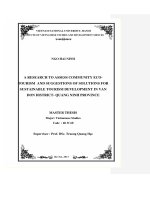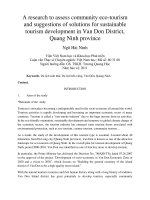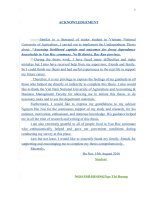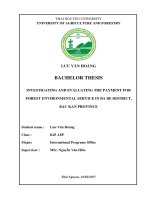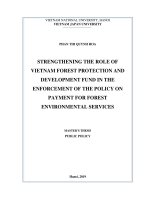Investigating and evaluating the payment for forest environmental service in ba be district, bac kan province
Bạn đang xem bản rút gọn của tài liệu. Xem và tải ngay bản đầy đủ của tài liệu tại đây (949.83 KB, 70 trang )
THAI NGUYEN UNIVERSITY
UNIVERSITY OF AGRICULTURE AND FORESTRY
LƯU VĂN HOÀNG
BACHELOR THESIS
INVESTIGATING AND EVALUATING THE PAYMENT FOR
FOREST ENVIRONMENTAL SERVICE IN BA BE DISTRICT,
BAC KAN PROVINCE
Student name :
Lưu Văn Hoàng
Class :
K45 AEP
Major:
International Programs Office
Supervisor :
MSc. Nguyễn Văn Hiểu
Thai Nguyen, 16/02/2017
`
DOCUMENTATION PAGE WITH ABSTRACT
Thai Nguyen University of Agriculture and Forestry
Degree program
Bachelor of Environmental Science and Management
Student name
Luu Van Hoang
Student ID
DTN1354120136
Thesis title
Investigating and evaluating the payment for forest
environmental service in Ba Be district, Bac Kan province
Supervisor
MSc. Nguyễn Văn Hiểu
Abstract:
Payment for forest environmental services is a policy that creates a payment
mechanism between users of PFES and PFES providers, to socialize the forest
protection and promotion the economic value of forest environment in the context of
wood resources of natural forests, have been depleted and the State budget capital
investment in forest protection is very limited. In recent years, PFES policy has
brought about practical and important effects for soil protection, erosion control,
sedimentation of lakes, rivers and streams; regulating the maintenance of clean water
for production and social life; carbon absorb and storage, reduction of greenhouse gas
emissions; protect the natural landscape and preserve the biodiversity of forest
ecosystems; provide spawning grounds, food sources and natural seedlings, and use
water from forests for aquaculture. It also contributes to the income of people living in
the forest.
Derived from above, the research: "Evaluation of payment for forest environment
i
`
services in Ba Be district" is very significant in the payment for forest environment
services, contributing to acknowledge the details on payment for forest environmental
services has been implemented in recent years in the Ba Be district.
Number of pages
72
Date of submission
20/09/2017
Supervisor’s
signature
ii
`
ACKNOWLEDGEMENT
To complete this thesis, first of all, I would like to express my deep gratitude to
my thesis supervisor: MSc. Nguyễn Văn Hiểu. He helpfully guided and helped me
during the implementation process of my thesis.
I would like to thank the Rector Board
of Thai Nguyen University of
Agriculture and Forestry that dedicated teaching, guiding and caring, create the
facilitate in my process of study and research.
I would like to send my thanks to the managers and staffs of Bac Kan Forest
Protection and Development Fund have helped me during the process of investigating
and collecting the data to complete my thesis.
Despite many efforts, due to the limited time and the level of the subject, the
inevitable shortcoming of the topic. I hope to receive valuable comments from my
teachers and friends to more complete.
I also thank you to teacher, officers of Advance Education Programs office
Sincerely thank!
Thai Nguyen, June 29, 2017
Student
Luu Van Hoang
iii
`
LIST OF TABLES
Table 4.1: Forest types, current status, overall forest PES provides for units using PES
.................................................................................................................................. 43
Table 4.2: Statistics on land area of Dong Phuc commune ...................................... 45
Table 4.3: Forest types, current status, overall forest PES provides for units using PES
.................................................................................................................................. 50
Table 4.4: Payments for forest environmental services in 2016 for non-forest owners
.................................................................................................................................. 51
Table 4.5: Payments for forest environmental services in 2016 for owners are
individual household ................................................................................................ 52
Table 4.6: Summary of forest land use status of Ba Be district ............................... 53
Table 4.7: Revenue and total income from forest protection of Ba Be farmers ...... 54
Table 4.8: Amount of payment for forest owner are state and non-state ................. 60
Table 4.9: Amount of payment for forest owner are community and individual..... 60
iv
`
LIST OF FIGURES
Figure 3.1: The administrative map of Ba Be district .............................................. 26
Figure 4.1: The payment for forest ecosystem services map in Ba Be district – Bac
Kan province 2017.................................................................................................... 41
Figure 4.2: The payment for forest ecosystem service map in Dong Phuc commune, Ba
Be district, Bac Kan province ................................................................................... 44
Figure 4.3: The payment for forest ecosystem service map in My Phuong commune,
Ba Be district, Bac Kan province ............................................................................. 47
Figure 4.4: The payment for forest ecosystem service map in Quang Khe commune,
Ba Be district, Bac Kan province ............................................................................. 48
v
`
LIST OF ABBREVIATIONS
Mod
: Moderator
PFES
: Payment for Environment Service
SOC
: Socioeconomic
CPC
: Commune People's Committee
USD
: Dolar
RUPES
: Rewarding Upland Poor for Environmental Services
RES
: Receive environmental services
MONRE
: Ministry of Natural Resources and Environment
IFAD
: International Fund for Agricultural Development
IUCN
: International Union for Conservation of Nature and
Natural Resources
RCFE
: Center for Research on Forest Ecology and
Environment
CLD
: Certificate of land use right
ICRAF
: International Council for Research in Agroforestry
IDDRI
: Institute for Sustainable Development and
International Relations
vi
`
TABLE OF CONTENT
PART I: INTRODUCTION .................................................................................... 1
1.1.Research rational ............................................................................................... 1
1.2.Research’s objective.......................................................................................... 4
1.3.Research questions and hypotheses .................................................................. 5
1.4.Definition .......................................................................................................... 5
PART II: LITERATURE REVIEW ....................................................................... 6
2.1.Legal foundations .............................................................................................. 6
2.2.Theoretical foundations..................................................................................... 6
2.2.1.Definition of forest ...................................................................................... 6
2.2.2.Forest classification in Vietnam ................................................................. 8
2.2.3.The concept of payment for forest environment service (PFES) ................ 9
2.3.Practical basis .................................................................................................. 15
2.3.1.Research situation in the world ................................................................ 15
2.3.2.Research situation in Vietnam .................................................................. 16
PAST III: CONTENTS AND METHODS ........................................................... 18
3.1.Materials .......................................................................................................... 18
3.1.1.Object and domain of the research ........................................................... 18
3.1.2.Research period ........................................................................................ 18
3.2.Research content ............................................................................................. 18
3.3.Methods ........................................................................................................... 19
3.3.1.Methods of analysis and theoretical synthesis ......................................... 19
3.3.2.Collect information and data on research subjects .................................. 20
3.3.3.Analytical methods of data processing ..................................................... 20
3.3.4.Inheritance method ................................................................................... 21
PART IV: RESULTS ............................................................................................. 22
4.1.Natural, economic and social conditions of Ba Be district ............................. 22
4.1.1.Natural condition ...................................................................................... 22
4.1.2.Socio-economic development.................................................................... 27
4.2.The objects and the area to pay for forest environmental services ................. 32
vii
`
4.3.Evaluation of payments for forest environment services in Ba Be district .... 34
4.4.Evaluation of payment for forest environmental services on each forest type 42
4.5.Revenue and total income from forest protection of farmer households in Ba Be
............................................................................................................................... 46
4.6.General observe the application of policy on payment for forest environment
services in Ba Be district ....................................................................................... 47
4.7.Assessment of PFES policies on the people of Ba Be district ........................ 54
4.7.1.General evaluation of the district ............................................................. 54
4.7.2.Feedback from local people...................................................................... 55
PAST V: DISCUSSION AND CONCLUSION ................................................... 57
5.1.Discussion ....................................................................................................... 57
5.2.Conclusion....................................................................................................... 59
REFERENCES ....................................................................................................... 61
viii
`
PART I. INTRODUCTION
1.1.Research rational
Payment for forest environmental services (PFES) is the supply and payment
relationship between the providers and users of forest environmental services. For
more than a decade, the attention and funding from international organizations have
enabled the testing of several different PFES mechanisms, especially in the fields of
river basin protection and carbon reduction. Excluding China - the state managed, in
other countries in Asia, these problems are solved in the form of community projects
which are small scale and fragmentation (Young, Oran R et al, 2003).
The developments of PFES in developing countries usually follow by the priority
decisions based on a fair system. Some countries suppose that PFES is a marketable
tool for ensuring environmental services such as carbon emissions reduction, river
basin protection, and biodiversity conservation. The central focus of plans and projects
in these countries is to promote market efficiency. However, the rigid application of
this approach in developing countries may increase the risk of livelihood to the poor
people.
In Vietnam, during the last two decades, the forestry sector in Vietnam has been
changed in policy and practice. The forest concentration management model with the
central purpose is resources exploitation have been changed into the forestry
socialization model, focusing on environmental protection, social development and the
promotion of local forestry enterprises. These changes reflect the response of the
forestry sectors to forest resource degradation and the inefficiency of centralized forest
management systems. Since the early 1990 's, through the program 327 and 5 million
1
`
ha of forest (program 661) deployment by the Ministry of agriculture and rural, there
are large number of of households and individual who are contracted forest or
allocated forest, protection land, afforestation and long term management. With the
high level of participation of the society in afforestation and forest protection, the
forest coverage increased from 28,2% in 1995 to 36,7% in 2004. The program (661) is
evaluated that have contributed to reduce the poverty and improve livelihoods for
about a million people in Vietnam.
However, the cost for forest conservation activities is a financial burden for the
Government. In these programs, although the result of improving forest environmental
services benefits many people and businesses upstream and downstream, the funding
for conservation and social development is mainly funded by the state budget. For
sustainable forest conservation and development, the government publishes a decision
380/QĐ-TTg in April 2008 - The pilot policy of payment for forest environmental
services to provide the basis for developing a legal framework of PFES on national
scale. This policy clearly define the benefit, jurisdiction and obligations of those who
are paid and pay for forest environmental services. Creating a sustainable economic
basis for forest protection and development, environmental and ecosystem protection,
improving the quality of delivery services, especially ensuring water for electricity,
water production and tourism business.
Decree No.99/2010/ND-CP dated 24/9/2010 (hereinafter referred to as Decree 99),
the Government's policy on payment for forest environmental services (PFES) began
implementation of 01/01/2011.
2
`
This is a policy creates a payment service mechanism between users of forest
environmental services and those who provide forest environmental services, to
socialize the forest protection and promotion of the economic value of forest
environment, in the context that natural forest resources are exhausted and the state
budget for forest protection is very limited. In recent years, PFES policy has bring
about practical and important effects for forest protection, increasing income for
people living in the forest zone, contributing to the supply of water for clean water
production, natural landscapes for tourism, environmental protection and response to
climate change.
Decree No.99/2010/ND-CP issued on 24 September 2010, (referred to as Decree
99) on Payment for Forest Environmental Services (PFES) has been implemented by
the government in Bac Kan province in recent years.
1) Mobilizing social resources for forest protection and improve the economic value
of the forest environment by establishing service and payment relationships
between the supplier and the user of forest environmental services.
2) Using the income from PFES to increase income for households participating in
forest protection to provide PFES, improving the effectiveness of forest protection.
3) Create a new financing mechanism for the forestry sector by using non-state budget
funds for forest protection.
Implement policy on payment for forest environmental services, Bac Kan has
established the Protection and Development Fund of the provincial forest. To fund
operated effectively, the province chose staffs quality, capability and responsibility to
participate in Rector Board, Supervisory Board, construction and strict implementation
3
`
of the charter, operating regulations. Assign the Department of Agriculture and Rural
Development to assume the prime responsibility for promulgating and guiding the
implementation of the policy on payment for forest environment services.
The Fund Management Board has done a good job of propagandizing, guiding
and proactively providing opinions to help the provincial People's Committee and
Department of Agriculture and Rural Development issue appropriate guidelines, use
revenues to promptly serve the protection and development of forests. As a result, the
provincial Forest Protection and Development Fund paid for environmental services to
four state forest owners, 40 non-forest owners are assigned forest management
responsibility by the state, 7.206 forest owners are households, individuals, village
communities in the province with a total paid area of over 80.000ha with a total
amount of over 13,6billion(VND). The payment is not only timely, but also contributes
to job creation, hunger eradication, poverty reduction and livelihood improvement.
contributing to the province's forest coverage to 71% by 2015, bringing Bac Kan
became one of the provinces with the highest forest coverage nationwide
(B.V.Catacutan, 2014).
1.2.Research’s Objectives
- Investigating and evaluating the natural conditions and the social economic
situation of agriculture and forestry of the people in Ba Be.
- Clarifying the relationship between landscapes, land use and forest
environmental services in Ba Be.
- Research on payments for forest environmental services (PFES) in Ba Be
district in 2017.
4
`
1.3.Specific objectives
- Understanding the laws of the government for payment for forest environmental
services.
- Understanding to apply the regulations, laws and legal documents on payment
for forest environmental services.
- Ensuring the data accuracy of payment for forest environmental services in Ba
Be district.
- Make recommendations, proposals that are realistic, highly feasible.
1.4.Definitions
- In research: Synthesize generalizations of the theoretical and practical basis of
relevant information on forest, environment, and payment for forest environmental
services.
- Practical significance: Research and evaluate the environmental services
description in Ba Be district, then find out the appropriate solutions to solve the
difficulties in order to improve the effectiveness of environmental service payments.
5
`
PART II. LITERATURE REVIEW
2.1.Legal foundations
− Pursuant to the Government's Decree No.99/2010/ND-CP of September 24,
2010 on the policy on payment for forest environment services.
− Decree 147/2016/ND-CP amending Decree 99/2010/ND-CP on payment for
environmental services.
− Circular No.34/2009/TT-BNNPTNT dated June 10, 2009 of the Ministry of
Agriculture and Rural Development stipulates the criteria for identifying and classifying
forests.
− Circular No.80/2011/TT-BNNPTNT Guiding the method of determining
payments for environmental services.
− Joint Circular No.62/2012/TTLTBNNPTNT-BTC Guiding the mechanism for
management of use of payment for forest environment services.
2.2.Theoretical foundations
2.2.1.Definition of forest
According to FAO, forest is defined as land with tree crown cover (or
equivalent stocking level) of more than 10% and the area of more than 0.5ha. The trees
should be able to reach a minimum height of 5 meters at maturity in situ. Forests
consist of two cases that create closed and expanded forests where previously trees
have grown on different levels and the floor contains a large proportion of the ground,
whereas the later is characterized by a continuous vegetation cover in which the cover
of the tree exceeds 10 percent. Furthermore, underforest reffers to the young natural
6
`
stands and all plantations established for forestry purposes, which have yet to reach a
cover density of 10 percent or tree height of 5 meters.
On September 24, 2010, the Vietnamese Government issued Decree
No.99/2010/ND-CP to provide completed definitions and relevent concepts about
forests as following:
Forest environment consists components of the forest ecosystem such as
plants, animals, microorganisms, water, soil, air, natural landscapes, and has values on
serving the needs of people and society, which is called the value in use of forest
environment. In addition, forest features numeric functions on land protection, water
source regulation, watershed protection, coastal protection, natural disaster prevention,
biodiversity, absorption and carbon storage, tourism, residence and reproduction of the
species, timber and other forest products.
Forest environmental services provide value for the use of the forest environment
to meet the needs of society and the lives of the people, including the types of services:
+ Protect soil, limit erosion and sedimentation of lakebed, river bed, stream bed.
+ Regulate and maintain water resources for production and social life.
+ Forest carbon sequestration and preservation, reduction of greenhouse gas
emissions by measures to prevent degradation, reduction of forest area and sustainable
forest development.
+ Protect the natural landscape and preserve biodiversity of ecosystems for
tourism.
7
`
+ Service provided breeding grounds, food supply and natural breeding, use of
water resources from the forests for aquaculture.
− In 1930, Morozov came up with the notion that forests are a whole,
interconnected, that occupy a certain amount of space on the ground and at the surface.
Forests occupy most of the Earth's surface and are part of the geographic landscape
(Shaw, & Oldfield, 2007).
− In 1952, M.E. Forests are part of the geographic landscape, which includes a
whole of trees, shrubs, plants, animals and microorganisms. During their development
they have a biological and affective relationship with each other and with external
circumstances.
− In 1974, I.S. The forest shows that forests are the complex formation of nature,
the basic part of the Earth's biosphere.
− The role of forest: the forest is an ecosystem that forest biomes dominant role
in the interactive relationship between organisms with the environment. The forest has
a very important role in lives of humans and the environment: Provide a source of
timber, air conditioning, produce oxygen, water, animals and plants and residential
holding rare genetic resources protection, prevent wind, protection of soil erosion,
protect human health life…
2.2.2. Forest classification in Vietnam
Under the Law on Protection and Development of Forest of the National
Assembly (Forest Law No. 29/2004/QH11), forests, based on the main use purpose, can
be classified into:
8
`
1) Protection forest: Protection forests are used mainly to protect water sources and
land, prevent erosion and desertification, restrict natural calamities and regulate
climate, thus contributing to environmental protection. Protection forest may
include headwater protection forests, wind- shielding and sand-shielding protection
forests, protection forests for tide shielding and sea encroachment prevention and
protection forests for environmental protection. Protection forests are presumably
planted on protection forest land.
2) Special-use forest: Special-use forests, which are used mainly for conservation of
nature, specimens of the national forest ecosystems and forest biological gene
sources, for scientific research, protection of historical and cultural relics as well as
landscapes, in service of recreation and tourism in combination with protection,
contributing to environmental protection. Special-use forest may include national
parks, natural conservation zones, landscape protection areas, and scientific
research and experiment forests. Special-use forests are presumably planted on
special-use forest land.
3) Production forest: Production forests are used mainly for production and trading of
timber and non-timber forest products in combination with protection, contributing
to environmental protection. Production forests are planted on production forest
land.
In addition, Article 3.1 of the Forest Law provides that forests include planted
forest and natural forest, in which, natural forest is forest which already existed and
which is not grown or planted by human being, and planted forest, by contrast, is
forest which is planted by human being (noble et al, 2000).
9
`
2.2.3.The concept of payment for forest environmental services (PFES)
According to Mayran and Paquin (2004), the basic idea of payment for forest
environmental service to create incentives for individuals and communities to protect
environmental sevices by compensating them for the costs incurred in managing and
providing those services. PFES consists of five key elements: voluntary transactions, a
well-defined environmental service, at least one buyer of that service and one supplier
of that service and conditionality (the buyer makes payments only if the survice supplier
continuously secures the provision of that service). In simplicity, PFES is a commitment
to enter a voluntary agreement with a legally binding contract at where buyers pay
money for forest and ecosystem protection services identified by money or support for
one or more sellers. The seller whereas is responsible for ensuring and developing
mentioned forest and ecosystem protection services in order to enlarge and optimize
the benefits of forest development (Westerink, Buizer & Ramos, 2008).
In Vietnam, the goals of PFES program are to improve forest quality and quantity,
increase the forestry sectors contribution to the national economy, reduce the state’s
financial burden for forest protection and management, and improve social well-being.
The role of payment for forest environmental services :
+
First, PFES provides a stable annual source of funding dedicated to forest
protection and management, it will help to reduce the annual expenditure of the state
budget for forestry investment.
+
Second, PFES help to expand the area of forest protected. Mobilize and create
more opportunities for households, household groups and communities to participate
10
`
in forest protection, management programs and policies. This policy has helped to
supplement income for households involved in forest protection.
+
Third, generate new revenue streams, support extra operating costs for state
forest owners, such as management boards of special-use forests, protected forests or
forestry companies in the context of state budget support for forest protection are
facing many difficulties.
Forms of payment for environmental services of forests
• Direct payment:
+
Direct payments are those using forest environmental services that pay
directly to the forest environmental services provider.
+
Direct payments are applied where the user of forest environment services
has the capacity and conditions, to make direct payments to the environmental service
provider without the intermediary organization. Direct payments are made on the
basis of a voluntary agreement between the user and the forest environment service
provider in accordance with the provisions of this Decree, in which the payment rate
is not lower than that prescribed by the State for the same type of forest
environmental services.
• Indirect payments:
Indirect payments are those who use forest environment services to pay the forest
environmental services providers entrusted through the Vietnam Forest Protection and
Development Fund or the provincial Forest Protection, the provincial-level People's
Committees shall decide on the replacement of the tasks of provincial-level forest
protection and development funds .
11
`
Indirect payments apply in cases where the user of forest environment services is
not able and able to pay directly to the forest environmental services, provider through
the intermediary organization. Indirect payments have the intervention and support of
the State, the price of forest environmental services provided by the State.
Specify 5 types of PFES:
a) Land protection, erosion control and sedimentation of lakes, river beds and
stream beds.
b) Regulation and maintenance of water resources for production and social life.
c) Carbon capture and storage of forests, reduction of greenhouse gas emissions
by measures to prevent degradation, reduction of forest area and sustainable
forest development.
d) Protect the natural landscape and preserve biodiversity of forest ecosystems for
tourism services.
e) Providing spawning grounds, feed sources and wild seed, using water from
forests for aquaculture.
Regulation principles payments
a) PFES is money from organizations and individuals in the society that use and
benefit from PFES have to pay.
b) Paying on PFES by cash through direct and indirect payment.
c) PFES payments through the Forest Protection and Development Fund (FPDF)
are the funds of the PFES entrusted by the PFES have to pay to PFES owners. PFES is
not a state budget and the FPDF is under the mandate of the PFES.
12
`
d) PES is a factor in the cost of products using PFES and does not replace
royalties or other payables in accordance with the law. Enterprises can take an account
of PFES into the cost of production and will represent those who use their products to
pay for forest protection and development expenditures. PFES are not taxes, fees and
charges.
e) To ensure publicity, democracy, objectivity and justice. PFES payment
process from where the payment to Forest Protection and Development Fund, to forest
owners and forest contractors households must be public, there is a discussion to reach
consensus, in accordance with the specific conditions of the locality and ensure
fairness in pay.
Specify the payers and rates
a) Hydropower generation facilities must pay for land protection services, limit
erosion and sedimentation of lakes and streambeds, to regulate and maintain
water resources for hydropower generation.
b) The production facilities and supply of clean water should pay for services of
regulating and maintaining water sources for drinking water production.
c) The industrial production facilities that use water directly from the water
source to pay services of regulating and maintaining water sources for
production.
d) Organizations and individuals doing business in tourism services who benefit
from forest environment services must pay for the services of natural landscape
protection and conservation of biodiversity in the forest ecosystem service of
tourism services.
13
`
e) The object must pay for service and storage of carbon absorbed by forests,
service provided breeding grounds, food supply and natural breeding, use of
water resources from the forests for aquaculture.
Formula and calculation of payments for forest environmental services
-
Amounts paid to forest owners are determined as follows:
Total amount paid to
the person paying for
forest environmental
services in the year
(VND)
Average level of
payment for 1
ha of forest
(VND/ha)
Forest area covered
by
the
person
paying for forest
environmental
services
management and
The average level of payments per hectare of forest is defined as the total amount of
money collected from the payers of forest environmental services, in the basin at the
time of inspection by the agency, confirmation as a basis for payment for forest
environmental services.
The forest area managed and used by the forest environmental service users are the
area allocated, leased or contracted for forest protection stable and long-term forest at
the time declaration of payment.
Coefficient K is the coefficient for adjusting the level of payments for forest
environmental services, it depends on the type of forest (protection forest, special use
forest, production forest), forest status (rich, medium, poor forest, regenerated forest).
The origin of forest formation (natural forest, plantation forest). When applying this
formula to the calculation of environmental services values of Ba Be district, this
formula is calculated as follows:
14
`
0,9 Dx20
S
In which:
- P: is the average payment per hectare in VND/ha
- D: is the average annual electricity output of Na Hang and Ta Lang hydropower
plants (KWh/year)
- S: is the total area in the Nang River basin (ha)
- 0.9 is the rate of direct use payments for forest protection as defined. Then we apply
the calculation of the amount paid to the district, calculated according to the formula
below:
C = PxA
In which:
- C is the amount paid for each pilot district (VND)
- P is the average payment per hectare of forest (VND/ha)
- A is the area of the district had been paid (ha).
Then, we will consider and calculate the adjustment coefficient of K to suit the forest
type and function of the forest and suitable for each district in Ba Be district.
15
`
2.3.Practical basis
2.3.1.Research situation in the world
Although PFES is a new concept in thinking and practice conservation of
nearly decade ago. However, it has quickly become popular in some countries. The
development of PFES has been increasingly widespread and in some countries, PFES
has been institutionalized in legal documents. Currently, the PFES has emerged as a
policy solution to encourage and share the benefits of the community and society.
Developed countries in Latin America have used the earliest PFES models. In
Europe, some governments have paid much attention to investing and implementing
many PFES schemes and models,(Wunder, 2005). In Australia has been legally
responsible for carbon emissions since 1998, allowing investors to register their
ownership of carbon sequestration. PFES has also been developed and piloted in Asia
such as Indonesia, the Philippines, China, India, Nepal and Vietnam. In particular,
Indonesia and the Philippines have many PFES case studies on watershed
management.
2.3.2.Research situation in Vietnam
Report "Three Year Implementation of Forest Environmental Services Payment
Policy in Vietnam (2011-2014)",(Law, (2011). This report is an independent
consultative report, conducted by international and national experts. To provide the
Directorate of Forestry and Vietnam Forest Protection and Development Fund (VNFF)
with comments and assessments from the experts perspective on the 3-year process,
and the content that needs to adjust PFES policy to serve the preliminary review of 3
years of PFES policies implemented by the Government and the Ministry of
16


